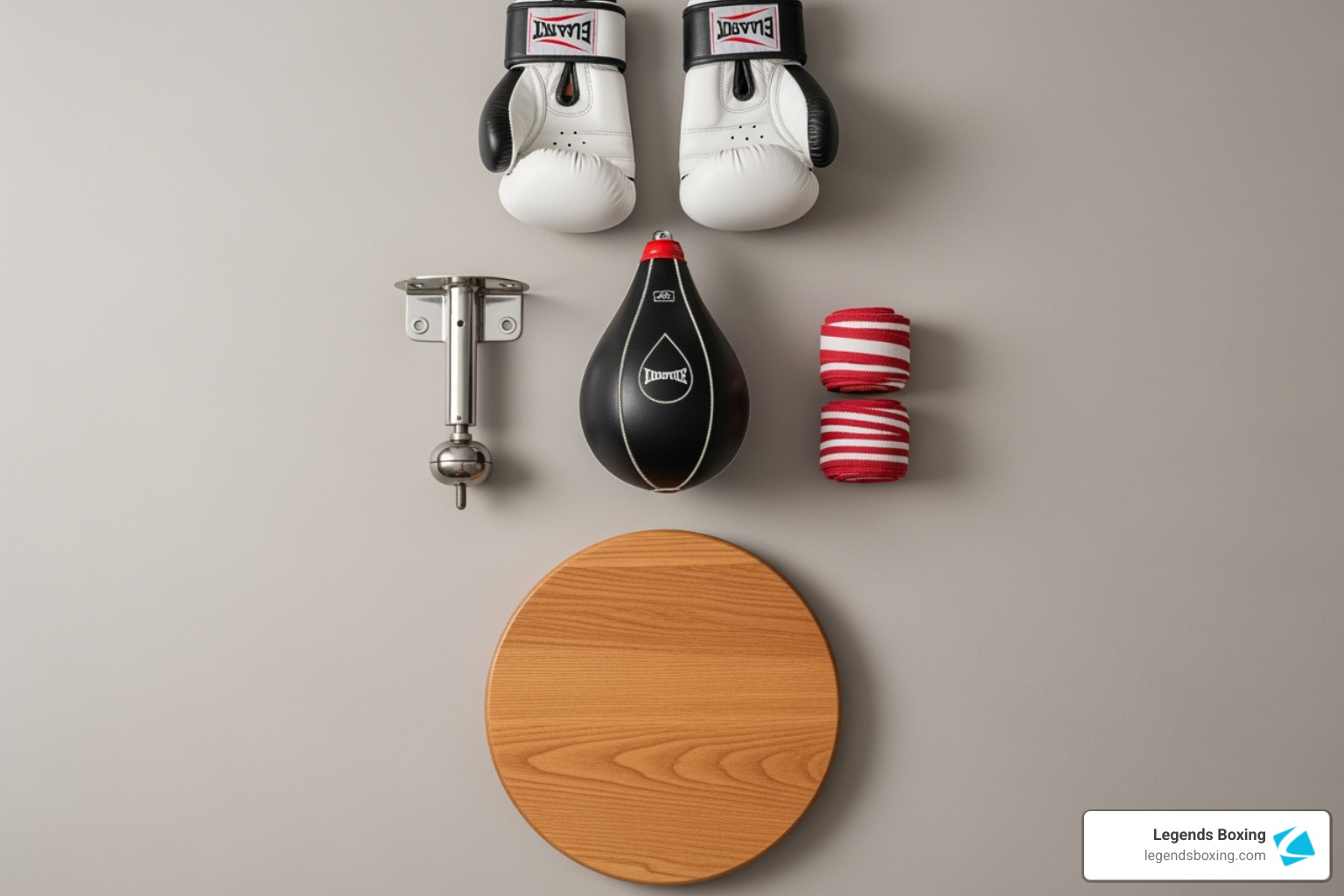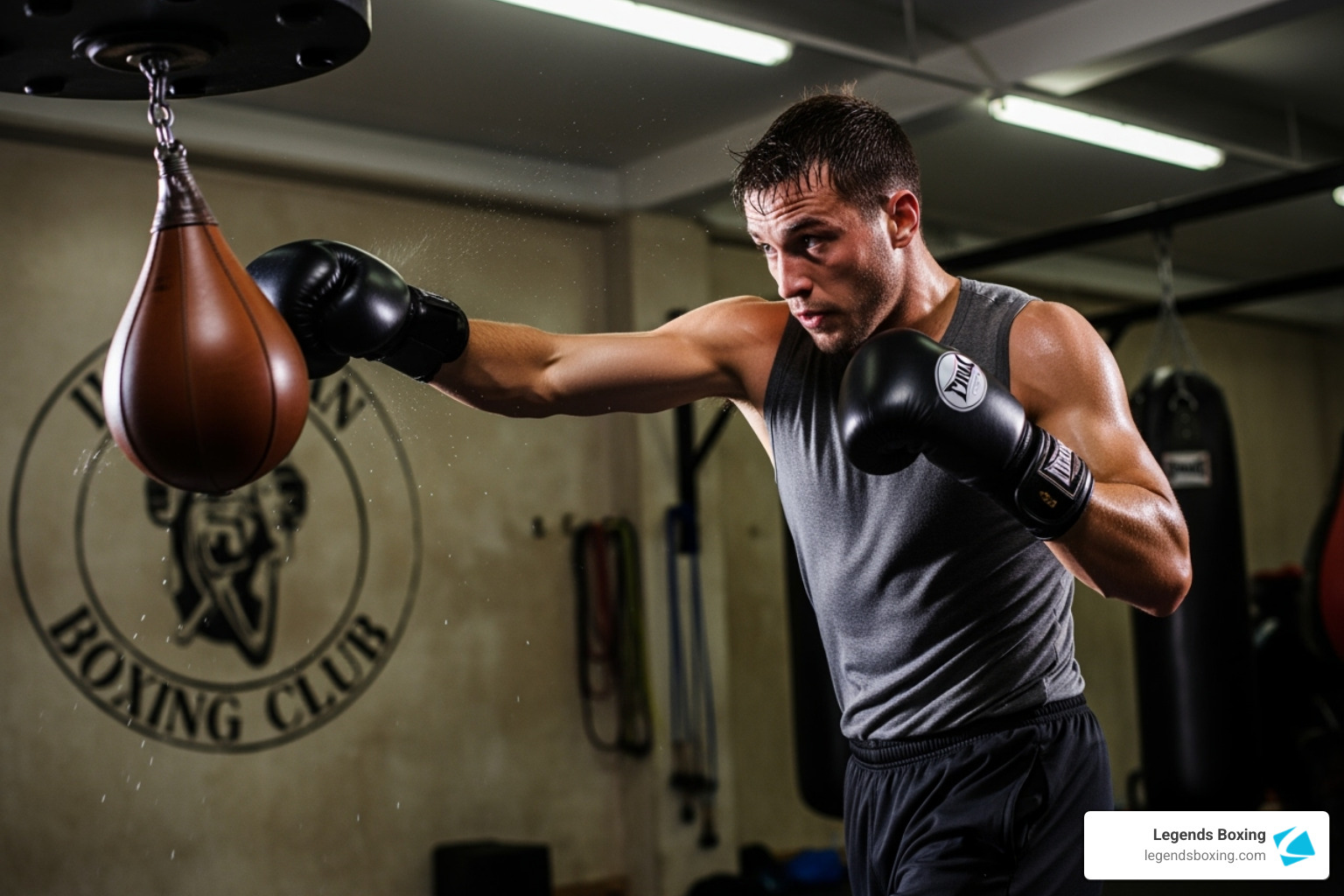Speed Bag Secrets: 10-Minute Drills for Rapid Improvement
Why Speed Bag Drills Transform Your Boxing Fitness
A speed bag drill is a focused exercise where you rhythmically strike a small, air-filled bag to improve hand-eye coordination, timing, and punch endurance. Walk into any boxing gym, and you'll hear its unmistakable rat-a-tat-tat sound. While it looks simple, mastering the bag's rhythm is a challenge that separates good boxers from great ones.
Quick Speed Bag Drill Essentials:
- The Basic Rhythm: Hit the bag and let it rebound three times before striking again (the "triplet rhythm").
- Starting Position: Stand square with feet shoulder-width apart, bag bottom at chin level.
- Beginner Pattern: Right-Right-Left-Left for consistent rhythm.
- Key Focus: Control over power—hit softly and build speed gradually.
- Practice Time: 10-15 minute sessions, 2-3 times per week for measurable improvement.
The good news? You don't need years of experience to see rapid improvement. Consistent practice builds the muscle memory, coordination, and endurance that sharpens your entire boxing game. The benefits extend far beyond the bag itself: stronger shoulders, faster hands, better cardiovascular health, and the mental focus to push through challenging workouts.
I'm Robby Welch, National Head Coach at Legends Boxing. I've seen how this simple tool transforms not just boxing skills but overall fitness confidence. These 10-minute drills will give you a workout that's anything but boring.

Speed bag drill terms to learn:
Why Every Boxer Needs the Speed Bag
Every boxing gym has three main bags: the heavy bag for power, the double-end bag for timing against a moving target, and the speed bag for precision. The speed bag hangs from a platform on a swivel, creating a short, rapid-fire rebound that demands split-second timing and laser focus. There's no room for sloppy technique; the bag will humble you, but it will also transform your skills faster than almost any other tool.
Heres how a consistent speed bag drill practice lifts your game:
- Builds Elite Coordination, Rhythm, and Timing: Your brain, eyes, and hands must sync perfectly to track the bag's movement and respond instantly. This translates directly to landing cleaner punches in the ring and finding openings in an opponent's rhythm.
- Develops Shoulder Endurance and Hand Speed: The drill keeps your arms lifted and moving, conditioning your shoulders to maintain your guard and throw punches round after round. You learn to relax and snap your punches with minimal movement, which builds faster, sharper strikes.
- Boosts Cardiovascular Health and Mental Focus: The constant arm movement provides a high-intensity cardio workout, strengthening your heart and lungs. The speed bag also demands complete attention, sharpening your mental discipline and focus in a form of moving meditation.
Gearing Up: Your Speed Bag Essentials
Getting your equipment right makes the difference between frustration and a satisfying rhythm.

- Speed Bag Platform & Swivel: A sturdy, securely mounted platform is non-negotiable. A wobbly base will ruin your rhythm. The swivel connects the bag to the platform; a quality, fast-moving swivel is essential for smooth action.
- The Speed Bag: Beginners should start with a larger bag (8-10 inches). Its slower movement gives you time to find your rhythm. As you improve, you can graduate to smaller, faster bags. Ensure the bladder is properly inflated.
- Hand Wraps & Gloves: Hand wraps are essential to protect your knuckles and wrists from repetitive impact. Light bag gloves offer extra cushioning, but avoid bulky sparring gloves.
- Proper Footwear: Boxing shoes or comfortable trainers provide the support needed for shifting your weight and staying agile.
Mastering the Basics: Rhythm and Form
Forget speed and power. Your only goals as a beginner are rhythm and control.

- The Triplet Rhythm: This is your foundation. When you hit the bag, it rebounds three times before you hit it again. Count it out: punch-1-2-3-punch. Say it aloud if it helps.
- Start Slow: Hitting the bag too hard sends it flying unpredictably. Use soft taps and focus on control. Speed comes naturally once you have control.
- Use Small Circular Motions: Guide the bag in small circles rather than hitting it with straight punches. This creates a smoother, more continuous rhythm.
- Proper Form: Stand square to the bag, feet shoulder-width apart, with your hands up. The bottom of the bag should align with your chin. Strike the bag with the side of your fist or heel of your hand, keeping your hands close to the bag for consistency.
Your 10-Minute Speed Bag Drill Workout
This simple speed bag drill workout fits into any fitness routine. Ten minutes of focused work is enough to leave your shoulders burning and your mind sharp. The structure mirrors actual boxing: 3-minute rounds with 1-minute rest periods, training your body and brain for intense bursts of activity.
Here's your 10-minute session:
- Warm-up (1-2 minutes): Start with light cardio like jumping jacks, followed by shoulder rolls and arm circles.
- Round 1 (3 minutes): Focus entirely on the Basic Rhythm Drill. Alternate hands while maintaining the triplet rhythm. Your only goal is consistency and control. Beginners can break this into shorter work intervals.
- Rest (1 minute): Walk around and shake out your arms.
- Round 2 (3 minutes): Continue the alternating rhythm but add subtle footwork. Shift your weight and take small steps around the bag to practice maintaining rhythm while moving.
- Rest (1 minute): Catch your breath and reset.
- Cool-down (1-2 minutes): Finish with gentle stretches for your shoulders, arms, and back.
Aim for 2-3 sessions per week. Consistency matters more than intensity.
Beginner-Friendly Speed Bag Drill Progression
The speed bag is humbling. The biggest mistake is trying to go too fast, too soon. Patience beats frustration. Build your skills one step at a time with this progression.
- Hit and Stop: Hit the bag once and catch it. This helps you feel the impact and response.
- Hit and Wait: Hit the bag and let it swing until it almost stops, then hit it again. This teaches timing and patience.
- Count the Rebounds: Hit the bag and count its bounces. Start by hitting it on the seventh rebound, then the fifth, and work your way down to the third. This trains your eyes and brain to work together.
- Right-Right-Left-Left Pattern: Hit twice with your right hand (with three rebounds between hits), then switch and hit twice with your left. This builds muscle memory on both sides.
- Single-Hand Drills: Work one hand at a time in short intervals to build individual shoulder strength and control.
- Alternating Hand Patterns: Seamlessly switch between right and left hands while maintaining the triplet rhythm. This pulls all the basic skills together.
For more detailed techniques and variations beyond these basics, check out these speed bag techniques.
The 5 Core Drills for Rapid Improvement
Once you have the basics, use these five essential speed bag drills to accelerate your progress. Each drill builds on the last, adding complexity while sharpening a specific skill.

The Basic Rhythm Drill (Front Circle Punch): This is your foundation. Stand square and use alternating fists to strike the bag in small, controlled circles, maintaining the triplet rhythm. This drill builds the fundamental muscle memory and hand-eye harmony.
The Alternating Hands Drill: An extension of the basic rhythm, this drill focuses on seamless transitions between your right and left hands. With no hesitation between strikes, you'll strengthen both arms equally and learn to deliver continuous punches.
The Double-Tap Drill: Tap the bag twice with the same hand before switching (Right-Right, then Left-Left). These taps must be quick and light. This speed bag drill is a game-changer for improving hand speed and punch combinations.
Side-to-Side Hits: Maintain your alternating rhythm while taking small steps left and right. This drill engages your whole body, teaching you to hit a moving target while improving agility, balance, and accuracy on the move.
Front Straight Punching: Instead of circular motions, deliver straight shots to the bag and retract your hand quickly. This develops a cleaner, more direct punch and trains your defensive recovery as you pull your hand back to avoid the rebound.
Level Up: Advanced Speed Bag Techniques
Once the basic speed bag drill feels like second nature, it's time to push your skills to the next level. Advanced drills are less about raw speed and more about nuanced control, rhythm variations, and incorporating defensive maneuvers. This is where you learn to manipulate the bag's movement, simulating the unpredictable nature of a real fight.
This level of training transforms the speed bag from a repetitive exercise into a dynamic workout that keeps your mind sharp and your reflexes razor-quick. You're no longer just learning the language of the speed bag—you're writing poetry with it.
Advanced Speed Bag Drill Combinations
These combinations challenge your coordination and timing, building on the foundation you've already established.

Reverse Punching: After a standard front punch, strike the bag as it swings back toward the platform. This reverse strike improves reaction time and teaches you to hit targets from multiple angles.
Elbow Strikes: This is about precision, not power. After a fist strike, catch the rebounding bag with an outward, inward, or downward elbow. This develops close-range fighting skills and improves body control.
Linking Combinations: Chain different strikes together in fluid sequences. For example, link a front circle punch with a reverse double punch or a front straight punch. These complex motor patterns build flow between different types of punches.
Changing Rhythm Drills: Deliberately vary your timing. Instead of always hitting on the third rebound, switch it up—hit on the second, then the fourth, then back to the third. This forces constant adaptation and sharpens your reflexes for unpredictable opponents.
Interval Training with Speed Bursts: Alternate between periods of maximum-speed hitting and slower, recovery-paced rhythm. Try 30 seconds of all-out speed followed by 30 seconds of controlled striking. This builds incredible stamina and anaerobic capacity for high-intensity bursts in the ring.
Frequently Asked Questions about Speed Bag Training
We've all been there: standing in front of a speed bag, wondering if we'll ever get the hang of it. At Legends Boxing, we hear the same questions from nearly everyone. Here are the answers.
How often should I practice speed bag drills to see improvement?
Consistency is more important than duration. We recommend practicing your speed bag drills 2-3 times per week for 10-15 minutes per session. This is enough to build muscle memory and see real progress. Start with shorter sessions (5-10 minutes) and gradually increase the time as your shoulder endurance and timing improve. Focused, regular practice is far more effective than one long, exhausting workout.
Why can't I get the rhythm right?
This is the most common frustration, and it's usually due to a few simple issues:
- You're hitting it too hard. Too much force makes the bag's movement unpredictable. Hit it softly. Think "control bag," not "speed bag."
- Your bag is too fast. A small or over-inflated bag moves too quickly for a beginner. Use a larger bag (8-10 inches) or let a little air out to slow it down.
- Your setup is wrong. The bottom of the bag should be level with your chin. If it's too high or low, your striking angle will be off.
- You're being impatient. The triplet rhythm takes time to internalize. Slow down, count the rebounds out loud, and focus on control. The rhythm will come.
What are the best speed bag drills for improving hand speed?
A speed bag drill is one of the best tools for developing hand speed, which comes from relaxation and efficiency, not brute force.
- The Double-Tap Drill: Hitting the bag twice with one hand before switching trains your hand to move faster without overthinking it. Start slow and build your pace.
- Two-Handed Speed Work: Hit the bag with both hands in rapid succession, creating a blur of motion. Focus on maximizing the number of light strikes in a set time, not on power.
- Interval Training: Alternate between bursts of maximum speed (15-30 seconds) and periods of controlled, slower rhythm. This trains your fast-twitch muscle fibers for explosive speed.
Most importantly, keep your shoulders relaxed. Tension is the enemy of speed. The more fluid you are, the faster your hands will move.
Become a Legend in the Ring
Mastering the speed bag drill mirrors the boxing journey itself. It demands patience, persistence, and humility. But when you stick with it, the rewards extend far beyond the gym. You'll develop sharper hand-eye coordination, lightning-fast hand speed, rock-solid endurance, and unwavering mental focus that helps you tackle any obstacle.
At Legends Boxing, we love seeing that "aha!" moment when the rhythm finally clicks. We've seen shy beginners transform into confident fighters and people who thought they'd never be athletic find their inner strength. The speed bag has a way of revealing your inner fighter, one triplet rhythm at a time.
Our boxing-based fitness classes combine real boxing techniques with conditioning and core exercises in a fun, results-driven alternative to the treadmill grind. No prior boxing experience is required—we'll guide you every step of the way. The real magic happens through consistent practice and proper form, and our professional coaches are here to help you succeed.
Ready to find what you're capable of? We're not just here to teach you boxing—we're here to help you become the strongest, most confident version of yourself. The speed bag is waiting.
Book a free workout with us today and take the first step toward becoming a legend in the ring.






